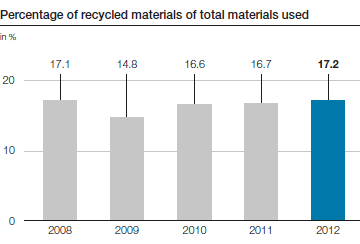Due to their ingredients, many of the by-products generated by the production and downstream processing of pig iron and steel can be utilized either internally as recycled materials or in other industrial branches (e.g., steel mill dust in the zinc industry) as secondary raw materials (by-products). Some by-products can be utilized directly as a product due to their particular physical and chemical characteristics.
Process management in the integrated metallurgical facilities is optimized on an ongoing basis in order to ensure a high degree of internal recycling and external utilization of by-products that accrue from both production facilities and downstream machinery, including filter dust and mill scale. Additionally, products, residual materials, and waste that accrue in external production facilities are also utilized in voestalpine production facilities, for example, scrap, plastic pellets, used oil, and used grease.
By using plastic in the blast furnace process (e.g., processed shredder residue, small-scale industry, production, packaging, and household waste), primary resources can be conserved.
The percentage of recycled scrap and other ferrous materials of all materials used (with the exception of raw materials that are energy sources, such as coal) is in the range of around 17 %.
The figures in the chart refer to steel production sites in Austria, Sweden, and Brazil. Sources of energy are taken into account under the chapter “Energy.”
voestalpine makes every effort to find continuous improvements with regard to material efficiency and new recycling possibilities in order to make a long-term contribution to a resource-conserving future.

